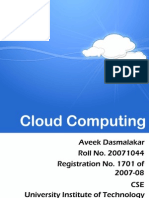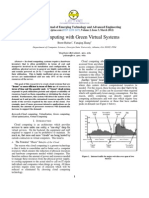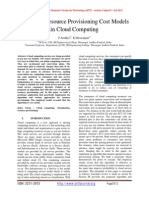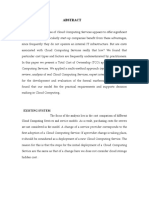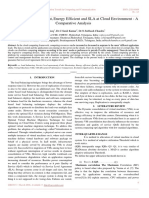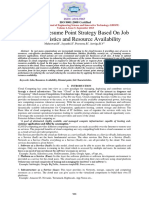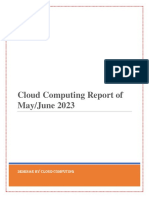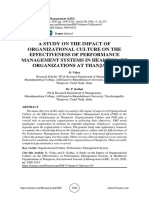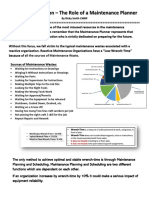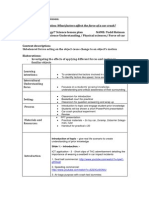Ijcet: International Journal of Computer Engineering & Technology (Ijcet)
Ijcet: International Journal of Computer Engineering & Technology (Ijcet)
Uploaded by
IAEME PublicationCopyright:
Available Formats
Ijcet: International Journal of Computer Engineering & Technology (Ijcet)
Ijcet: International Journal of Computer Engineering & Technology (Ijcet)
Uploaded by
IAEME PublicationOriginal Title
Copyright
Available Formats
Share this document
Did you find this document useful?
Is this content inappropriate?
Copyright:
Available Formats
Ijcet: International Journal of Computer Engineering & Technology (Ijcet)
Ijcet: International Journal of Computer Engineering & Technology (Ijcet)
Uploaded by
IAEME PublicationCopyright:
Available Formats
International Journal of Computer Engineering and Technology (IJCET), ISSN 0976-6367(Print),
ISSN 0976 - 6375(Online), Volume 5, Issue 7, July (2014), pp. 62-66 IAEME
62
CAPACITY MANAGEMENT ON CLOUD
Twisha, Amit Kr. Gautam, Jayant Sharma
1, 2
Assistant Professor, Cluster Innovation Centre, University of Delhi, India
3
Assistant Professor, University of Delhi, India
ABSTRACT
Cloud Computing allows users to modify number of resources in real time thus focusing on
computing as a utility that can be access over the Internet. We saw various phases starting from
Centralized Bulky systems to Distributed Networks and now the emergence of Cloud Computing
which is based on Centralized Systems with Internet as the access. Here the vendor i.e. the owner of
Cloud is authenticated to provide services to user as per his demand. These Clouds are location-
independent and have a flexible pricing model for the user. But for efficient use of these services,
these should be properly managed using Capacity Management as a tool. Cloud Computing is only
advantageous if Cloud Services are efficiently used.
Keywords: Cloud Computing, Capacity Management, Pay-as-you-go, Capacity Planning and Virtual
Cloud.
I. INTRODUCTION
Cloud Computing provides resources via internet, thus appearing to user as if the Cloud has
infinite capacity and pay as per the user demands. It mainly aims at the feature of Shared
Infrastructure, On-Demand-Service and Pay-As-You-Go. The advantages of Cloud Computing
are:
Doing-more-With-Less, this is with regard to infrastructure.
User can use the service without knowing the underlying technology
Enabling customer to use the resources as per need
Pay-for-What-you-use
Deployment models in cloud computing are Private Model; Public Model; Hybrid Model
INTERNATIONAL JOURNAL OF COMPUTER ENGINEERING &
TECHNOLOGY (IJCET)
ISSN 0976 6367(Print)
ISSN 0976 6375(Online)
Volume 5, Issue 7, July (2014), pp. 62-66
IAEME: www.iaeme.com/IJCET.asp
Journal Impact Factor (2014): 8.5328 (Calculated by GISI)
www.jifactor.com
IJCET
I A E M E
International Journal of Computer Engineering and Technology (IJCET), ISSN 0976-6367(Print),
ISSN 0976 - 6375(Online), Volume 5, Issue 7, July (2014), pp. 62-66 IAEME
63
II. ECONOMICS
Cloud Computing is highly expensive if proper monitoring is not adapted. As per the
economic statistics available Cloud Computing is almost 2.83 times expensive as compared to in-
house server without incorporating capacity management.
Lets compare an actual cost of a cloud server as compared to the equivalent in-house
infrastructure running within an enterprise. As an example of extra-large server on EC2 cloud
having 15GB of memory and 8 compute units. It costs $0.68 per CPU-hour to the customer.
Purchasing an equivalent server for in-house deployment costs $9500(approx). This price if for an
x86 server with 3 quad-core CPUs i.e. 12 processing cores, 12GB memory and 300GB disk. If we
run this in-house server for 3years i.e. 26260 hrs (approx), then the cost per hour will be $0.36/hr
over 3years. This cost compared to the cost of cloud server ($0.68 /hr), which is 2.83 times the cost
of an in-house server. Even if we discount the fact that in-house server has 12 cores compared to
EC2 servers 8 cores, the cloud server costs 1.88 times expensive.
As per the Table 1 cloud server is more expensive than an equivalent in-house server. But
now we consider the fact that most servers are heavily underutilizes, say about 40 percent, whereas
cloud server has much more utilization, say 80 percent. Factoring this in, the Cost/effective-hour
comes out to be $0.90 (i.e. cost /hr divided by the efficiency), whereas the same for a server
deployed in cloud comes out to be $0.85. Than adding the management cost, power & cooling cost,
etc in In-house server and the Management Cost in Cloud server, we can conclude that In-house
Server is 1.5 times (approx.) expensive than the cloud server. But this benefit can only be achieved if
we incorporate proper Capacity Management & Monitoring in the cloud server.
Table 1: Economics of Servers
In-House server Cloud Server
Purchase Cost $9,600
Cost/hr(over 3yrs) $0.36 $0.68
Price(Cloud/In-
House)
$1.88
Price of core-hr $0.03 (0.36/12) $0.09
Price 2.83 times expensive
Efficiency 40% 80%
Cost/Effective-hr $0.90 $0.85
Power & cooling $0.36
Management Cost $0.10 $0.01
Total Cost/Effective-
hr
$1.36 $0.86
CostRatio(In-
house/Cloud)
1.58 times expensive
III. PRACTICAL ISSUES
Amazon is the first cloud provider and it faced the following issues:
1. Complexity of the application suite
2. Peaks and throughs of seasonal retail business necessities were there. So, regular load
monitoring and provisioning additional capacity on demand was required.
International Journal of Computer Engineering and Technology (IJCET), ISSN 0976-6367(Print),
ISSN 0976 - 6375(Online), Volume 5, Issue 7, July (2014), pp. 62-66 IAEME
64
Using a public cloud offering astrict the need to plan ahead for peak load and converts fixed
costs into variable costs that change with actual usage, thereby eliminating wastage. In contrast,
provisioning for peak capacity is a necessity within private data centers. Without adequate scale
there is limited opportunity to amortize capacity across different applications.
IV. SOLUTION: CAPACITY MANAGEMENT
Vendors can address clients challenges by:
Prioritizing workloads
Maximizing business return by identifying well suited applications
Addressing problematic workloads
Identifying potential problems & addressing them before migration
Important driving force for cloud economics is the way hardware capacity is planned for and
purchased
Using a public cloud offering therefore obligates the need to plan ahead for peak load and
converts fixed costs into variable costs that change with actual usage, thereby eliminating wastage.
Thus this can be achieved by Capacity Management. Capacity Management is concerned with the
following:
1. Monitoring the performance, throughput and load on the system.
2. Analyzing the performance of the system.
3. Tuning the performance of the system as the existing requirements
4. Future planning/ Prediction as per the demands
5. Capacity Planning
Time and Capacity are the two potential constraints in Capacity Management. Considering
Cloud Computing, both these are major constraints to be taken care of.
40.00%
30.00% 20.00%
10.00%
10.00%
30.00%
Cloud Server
User A
User B
User C
User D
For an example, suppose we have a cloud server which is used by 5 users (as shown below).
We have the free space of 30%, but now the user B and user D leaves the space they have. So,
the space has to be lent out to other customers for cost profit. For this forecasting of the amount of
data which will be available in future will be predicted by the Capacity Management team. It will
monitor the present load on the system and will plan for future. If this analysis and planning is not
there, then the cloud server will have the following view:
International Journal of Computer Engineering and Technology (IJCET), ISSN 0976-6367(Print),
ISSN 0976 - 6375(Online), Volume 5, Issue 7, July (2014), pp. 62-66 IAEME
65
40.00%
20.00%
10.00%
70.00%
Cloud Server
User A
User C
User E
Free Space
Figure: Cloud Distribution
As per the chart, 70% of the space is free, thus major part of the server is wasted. It is often
argued that using virtualization and automatic provisioning technologies in-house it should be
possible to create a virtual cloud where these inefficiencies would disappear and benefits of cloud
computing could be achieved on premises. But if there is insufficient planning then shifting to cloud
server is a total waste, as can be seen in the example above.
V. TECHNIQUE USED
Let x1, x2, x3 xn be the respective demands of applications 1 to n. Also let X be the
summation of demands of all running applications, i.e.
X (t1) = x1 + x2 + x + +xn at a particular time t1
& the maximum of X() be Xmax ,i.e.
Xmax = max(X(t(x)) over time t
Variation in X and Xmax is affected by running of various applications. So if the difference
between X and Xmax is not much at maximum number of time then there is no use of providing
dynamic availability of the demands by various applications, so in this case Xmax can be provided
by the cloud server.
Figure: Cloud Over-Provisioning: Best Case
On the other hand if there is major difference between X and Xmax at maximum number of
times then the demand should be fulfilled dynamically which should be the actual demand at that
time with summation of a fixed variable (i.e. time taken to provide the demand) and the rate of
change of X.
International Journal of Computer Engineering and Technology (IJCET), ISSN 0976-6367(Print),
ISSN 0976 - 6375(Online), Volume 5, Issue 7, July (2014), pp. 62-66 IAEME
66
Figure: Cloud Over-Provisioning: Worst Case
So, the total virtual capacity that should be provided by the cloud service provider should be:
VC(t) =X(t) + * dX/dt, where is the provisional delay
VI. CONCLUSION
When dealing with a set of resources in cloud, capacity management can be metaphorically
viewed as making sure you have a big enough bucket to hold all of the water the business needs to
slake its thirst. There are boundaries on this pool of resources. Capacity management under this
"bucket" approach tends to center on predicting peak usage needs and ensuring that in-house data
centers can meet those demands.
REFERENCES
[1] Chris Molloy, Member, IBM Academy of Technology, Capacity Management for Cloud
Computing, 2009 IBM Corporation.
[2] Keith Jeffery [ERCIM], Burkhard Neidecker-Lutz [SAP Research], The Future Of Cloud
Computing, Expert Group Report, European Commision Information Society & Media.
[3] Gautam Shroff, Enterprise cloud computing: Technology, architeture, applications,
India/Cambridge University press/2011.
[4] Saurabh Kumar, Cloud Computing, 2nd Ed., New Delhi/Wiley India (P) Ltd/2012.
[5] Ron Potter, Capacity Management Ensures Success for Enterprise Cloud Consumers,
www.techquest.com.
[6] Daniel A. Menasce & Paul Ngo, Understanding Cloud Computing: Experimentation and
Capacity Planning, Proc. 2009 Computer Measurement Group Conf, Dallax, TX, Dec. 7-11,
2009.
[7] Davis Linthicum, How Capacity Management changes in the Cloud, InfoWorld.com.
[8] Amazon Web Services. Amazon Elastic Compute Cloud homepage.
http://aws.amazon.com/ec2, November 2008.
[9] Chappel D. Microsoft Azure homepage. Introducing the Azure Services Platform [Internet].
http://www.microsoft.com/azure/whatisazure.mspx, October 2008.
[10] Microsoft Azure homepage. http://www.microsoft.com/azure, 2008.
[11] Gurudatt Kulkarni, Jayant Gambhir and Amruta Dongare, Security in Cloud Computing,
International Journal of Computer Engineering & Technology (IJCET), Volume 3, Issue 1,
2012, pp. 258 - 265, ISSN Print: 0976 6367, ISSN Online: 0976 6375.
You might also like
- COMP1680 Coursework 1Document14 pagesCOMP1680 Coursework 1Tev WallaceNo ratings yet
- COMP1680 Coursework 1Document14 pagesCOMP1680 Coursework 1Tev WallaceNo ratings yet
- Distributor List Iphex - 2015Document62 pagesDistributor List Iphex - 2015Prasoon MishraNo ratings yet
- A View of Cloud ComputingDocument6 pagesA View of Cloud ComputingmasharabNo ratings yet
- Dynamic Resource Allocation Using Virtual MachinesDocument5 pagesDynamic Resource Allocation Using Virtual MachinesSaibaba GunturiNo ratings yet
- Cloud Computing, Seminar ReportDocument17 pagesCloud Computing, Seminar ReportAveek Dasmalakar78% (9)
- Above The Clouds: A Berkeley View of Cloud ComputingDocument23 pagesAbove The Clouds: A Berkeley View of Cloud Computingapi-3931606No ratings yet
- Ijetae 0312 01Document6 pagesIjetae 0312 01rosita61No ratings yet
- Energy-Aware and Power Efficient Cloud Computing: Aashka Kotecha, Shailee PatelDocument4 pagesEnergy-Aware and Power Efficient Cloud Computing: Aashka Kotecha, Shailee Patelrakesh7800_427023020No ratings yet
- Cloud Computing QT PreparationDocument42 pagesCloud Computing QT PreparationGarima PaudelNo ratings yet
- Important Questions of Cloud Computing1Document6 pagesImportant Questions of Cloud Computing1AreNo ratings yet
- The Case For Cloud ComputingDocument5 pagesThe Case For Cloud ComputingLuis SousaNo ratings yet
- A Review On Energy Efficient Cloud Computing AlgorithmsDocument5 pagesA Review On Energy Efficient Cloud Computing AlgorithmsInternational Journal of Application or Innovation in Engineering & ManagementNo ratings yet
- 1 Unit4cloudeconomicsDocument42 pages1 Unit4cloudeconomicsSubhadip DuttaNo ratings yet
- Cloud Computing: ABSTRACT-Computers Have Become AnDocument5 pagesCloud Computing: ABSTRACT-Computers Have Become AnRavi Shankar JaiswalNo ratings yet
- Optimized Energy Efficient Resource Management in Cloud Data CenterDocument2 pagesOptimized Energy Efficient Resource Management in Cloud Data CenterHimadri BhattacharjeeNo ratings yet
- Benefits of AWS in Modern Cloud Over On-Premises MethodDocument9 pagesBenefits of AWS in Modern Cloud Over On-Premises MethodIJRASETPublicationsNo ratings yet
- Topic:Cloud Computing Name:Aksa Kalsoom Submitted To:Sir Amir Taj Semester:7 ROLL# 11PWBCS0276 Section:BDocument6 pagesTopic:Cloud Computing Name:Aksa Kalsoom Submitted To:Sir Amir Taj Semester:7 ROLL# 11PWBCS0276 Section:BlailaaabidNo ratings yet
- Cloud Services Chargeback Models White PaperDocument10 pagesCloud Services Chargeback Models White PaperchmoreNo ratings yet
- Cloud Computing: An Overview: A Summary of Important Cloud-Computing Issues Distilled From ACM CTO RoundtablesDocument5 pagesCloud Computing: An Overview: A Summary of Important Cloud-Computing Issues Distilled From ACM CTO RoundtablesPriyesh AgrawalNo ratings yet
- Semi 3Document5 pagesSemi 3Sahana P HNo ratings yet
- Research Paper T212006 Cloud ComputingDocument9 pagesResearch Paper T212006 Cloud Computingabhijit kateNo ratings yet
- Resource Management PaperDocument8 pagesResource Management Paperruben16793570No ratings yet
- Survey Paper For Maximization of Profit in Cloud ComputingDocument6 pagesSurvey Paper For Maximization of Profit in Cloud ComputingseventhsensegroupNo ratings yet
- 2Document11 pages2Sourabh porwalNo ratings yet
- Term Paper Cloud ComputingDocument11 pagesTerm Paper Cloud Computingkuntal Roy Animation WorldNo ratings yet
- Exploring Resource Provisioning Cost Models in Cloud ComputingDocument5 pagesExploring Resource Provisioning Cost Models in Cloud ComputingseventhsensegroupNo ratings yet
- (IJCST-V8I3P11) :obada Qusai Hatem, Ahmad Saker AhmadDocument5 pages(IJCST-V8I3P11) :obada Qusai Hatem, Ahmad Saker AhmadEighthSenseGroupNo ratings yet
- Cloud ComputingDocument6 pagesCloud ComputingGHOST 007No ratings yet
- Abstract FullDocument7 pagesAbstract FullPooja BanNo ratings yet
- Cloud Computing: Ayush Garg 7CS - 17Document22 pagesCloud Computing: Ayush Garg 7CS - 17mridul64No ratings yet
- Dynamic Parallel Data Processing in Heterogeneous CloudDocument30 pagesDynamic Parallel Data Processing in Heterogeneous CloudAther AliNo ratings yet
- Virtual Machine Placement in A Virtualiz PDFDocument11 pagesVirtual Machine Placement in A Virtualiz PDFDr. Preethi DNo ratings yet
- Job Scheduling in Cloud Computing: A Review of Selected TechniquesDocument5 pagesJob Scheduling in Cloud Computing: A Review of Selected TechniquesInternational Journal of Application or Innovation in Engineering & ManagementNo ratings yet
- 2 1520673200 - 10-03-2018 PDFDocument8 pages2 1520673200 - 10-03-2018 PDFEditor IJRITCCNo ratings yet
- Job PDFDocument6 pagesJob PDFaswigaNo ratings yet
- Unit IvDocument21 pagesUnit Ivsaranya.cseNo ratings yet
- prathvinotesDocument12 pagesprathvinotesparth.flutter01No ratings yet
- Five Characteristics of Cloud ComputingDocument8 pagesFive Characteristics of Cloud ComputingragunathNo ratings yet
- 01 - 1 - Minimize SLA Violation and Power Consumption in Cloud Data Center Using Adaptive Energy Aware AlgorithmDocument15 pages01 - 1 - Minimize SLA Violation and Power Consumption in Cloud Data Center Using Adaptive Energy Aware AlgorithmhasniNo ratings yet
- 2 1534933963 - 22-08-2018 PDFDocument3 pages2 1534933963 - 22-08-2018 PDFRahul SharmaNo ratings yet
- Lecture 22 MeDocument27 pagesLecture 22 MesaviNo ratings yet
- SeminarDocument37 pagesSeminarPrathmesh JadhavNo ratings yet
- 4.profit MaximizationDocument14 pages4.profit MaximizationRamyaNo ratings yet
- Transformation To CloudsDocument7 pagesTransformation To Cloudsarunanand4101No ratings yet
- A Decentralized SelfDocument8 pagesA Decentralized Selfsphinkz28No ratings yet
- Resource Leasing Cloud Computing Model: A Win-Win Strategy For Resource Owners and Cloud Service ProvidersDocument5 pagesResource Leasing Cloud Computing Model: A Win-Win Strategy For Resource Owners and Cloud Service ProvidersJournal of ComputingNo ratings yet
- Cloud Computing: Technical Seminar Report OnDocument13 pagesCloud Computing: Technical Seminar Report OnRajesh KrishnaNo ratings yet
- Introduction To Cloud Computing: References Ae All Mentioned in The Last Two SlidesDocument29 pagesIntroduction To Cloud Computing: References Ae All Mentioned in The Last Two SlidesUzair MayaNo ratings yet
- Resource Provisioning and Resource Allocation in Cloud Computing EnvironmentDocument10 pagesResource Provisioning and Resource Allocation in Cloud Computing Environmentbella octaviaNo ratings yet
- Ijcet: International Journal of Computer Engineering & Technology (Ijcet)Document5 pagesIjcet: International Journal of Computer Engineering & Technology (Ijcet)IAEME PublicationNo ratings yet
- Profit Maximization5Document4 pagesProfit Maximization5KumarecitNo ratings yet
- Cloud Computing: An OverviewDocument5 pagesCloud Computing: An Overviewprasanthbab7128No ratings yet
- CC Unit 1Document115 pagesCC Unit 1ROHIT KASARNo ratings yet
- Load Balancing in Cloud ComputingDocument7 pagesLoad Balancing in Cloud ComputingChandan KumarNo ratings yet
- Exam AZ 900: Azure Fundamental Study Guide-1: Explore Azure Fundamental guide and Get certified AZ 900 examFrom EverandExam AZ 900: Azure Fundamental Study Guide-1: Explore Azure Fundamental guide and Get certified AZ 900 examNo ratings yet
- Cloud Computing and Virtualization: Streamlining Your IT InfrastructureFrom EverandCloud Computing and Virtualization: Streamlining Your IT InfrastructureNo ratings yet
- Cloud Computing For Beginners: Your First Step into the Future of TechFrom EverandCloud Computing For Beginners: Your First Step into the Future of TechNo ratings yet
- Cloud Computing Made Simple: Navigating the Cloud: A Practical Guide to Cloud ComputingFrom EverandCloud Computing Made Simple: Navigating the Cloud: A Practical Guide to Cloud ComputingNo ratings yet
- Broad Unexposed Skills of Transgender EntrepreneursDocument8 pagesBroad Unexposed Skills of Transgender EntrepreneursIAEME PublicationNo ratings yet
- Voice Based Atm For Visually Impaired Using ArduinoDocument7 pagesVoice Based Atm For Visually Impaired Using ArduinoIAEME PublicationNo ratings yet
- A Study of Various Types of Loans of Selected Public and Private Sector Banks With Reference To Npa in State HaryanaDocument9 pagesA Study of Various Types of Loans of Selected Public and Private Sector Banks With Reference To Npa in State HaryanaIAEME PublicationNo ratings yet
- A Study On The Impact of Organizational Culture On The Effectiveness of Performance Management Systems in Healthcare Organizations at ThanjavurDocument7 pagesA Study On The Impact of Organizational Culture On The Effectiveness of Performance Management Systems in Healthcare Organizations at ThanjavurIAEME PublicationNo ratings yet
- Influence of Talent Management Practices On Organizational Performance A Study With Reference To It Sector in ChennaiDocument16 pagesInfluence of Talent Management Practices On Organizational Performance A Study With Reference To It Sector in ChennaiIAEME PublicationNo ratings yet
- A Study On Talent Management and Its Impact On Employee Retention in Selected It Organizations in ChennaiDocument16 pagesA Study On Talent Management and Its Impact On Employee Retention in Selected It Organizations in ChennaiIAEME PublicationNo ratings yet
- Role of Social Entrepreneurship in Rural Development of India - Problems and ChallengesDocument18 pagesRole of Social Entrepreneurship in Rural Development of India - Problems and ChallengesIAEME PublicationNo ratings yet
- Various Fuzzy Numbers and Their Various Ranking ApproachesDocument10 pagesVarious Fuzzy Numbers and Their Various Ranking ApproachesIAEME PublicationNo ratings yet
- A Proficient Minimum-Routine Reliable Recovery Line Accumulation Scheme For Non-Deterministic Mobile Distributed FrameworksDocument10 pagesA Proficient Minimum-Routine Reliable Recovery Line Accumulation Scheme For Non-Deterministic Mobile Distributed FrameworksIAEME PublicationNo ratings yet
- Optimal Reconfiguration of Power Distribution Radial Network Using Hybrid Meta-Heuristic AlgorithmsDocument13 pagesOptimal Reconfiguration of Power Distribution Radial Network Using Hybrid Meta-Heuristic AlgorithmsIAEME PublicationNo ratings yet
- Application of Frugal Approach For Productivity Improvement - A Case Study of Mahindra and Mahindra LTDDocument19 pagesApplication of Frugal Approach For Productivity Improvement - A Case Study of Mahindra and Mahindra LTDIAEME PublicationNo ratings yet
- Financial Literacy On Investment Performance: The Mediating Effect of Big-Five Personality Traits ModelDocument9 pagesFinancial Literacy On Investment Performance: The Mediating Effect of Big-Five Personality Traits ModelIAEME PublicationNo ratings yet
- A Review of Particle Swarm Optimization (Pso) AlgorithmDocument26 pagesA Review of Particle Swarm Optimization (Pso) AlgorithmIAEME PublicationNo ratings yet
- Quality of Work-Life On Employee Retention and Job Satisfaction: The Moderating Role of Job PerformanceDocument7 pagesQuality of Work-Life On Employee Retention and Job Satisfaction: The Moderating Role of Job PerformanceIAEME PublicationNo ratings yet
- Camel Analysis of NBFCS in TamilnaduDocument7 pagesCamel Analysis of NBFCS in TamilnaduIAEME PublicationNo ratings yet
- Analyzability Metric For Maintainability of Object Oriented Software SystemDocument14 pagesAnalyzability Metric For Maintainability of Object Oriented Software SystemIAEME PublicationNo ratings yet
- 42M - Putzmeister SpecsDocument1 page42M - Putzmeister Specshomam gamilNo ratings yet
- Guide To Drawer Slides, A Pain-Free Slide InstallationDocument4 pagesGuide To Drawer Slides, A Pain-Free Slide InstallationRazvan Pascaniuc100% (1)
- URC SR 2016 Products Pp76-101 HiRes DigitalDocument26 pagesURC SR 2016 Products Pp76-101 HiRes DigitalDark ShadowNo ratings yet
- Features of Gothic Literature QuestionsDocument3 pagesFeatures of Gothic Literature QuestionsPatricia BarsanuNo ratings yet
- Ado PKD Io 1913: Chap 47 ReaDocument9 pagesAdo PKD Io 1913: Chap 47 ReaAnandmohanNo ratings yet
- Dnet Techbible 3 14 2007Document409 pagesDnet Techbible 3 14 2007guinho_17No ratings yet
- LysosomesDocument15 pagesLysosomesIqra MujeebNo ratings yet
- 25. Tuyển Tập Chuyên PT Năng Khiếu Từ 2011Document129 pages25. Tuyển Tập Chuyên PT Năng Khiếu Từ 2011viuyenNo ratings yet
- EDSC2019 Scientific ProgramDocument6 pagesEDSC2019 Scientific Programheart911hotmail.comNo ratings yet
- Board of Aeronautical Engineering SB 1Document3 pagesBoard of Aeronautical Engineering SB 1Cruz PlusNo ratings yet
- Pedrali Chair 3Document139 pagesPedrali Chair 3muhammadNo ratings yet
- 775i65g R2.0 PDFDocument38 pages775i65g R2.0 PDFAndrás CsenkiNo ratings yet
- Single Point Lesson - The Role of A Maintenance Planner PDFDocument3 pagesSingle Point Lesson - The Role of A Maintenance Planner PDFpradeep1987coolNo ratings yet
- SCIENCE MELC Grade 7 10Document14 pagesSCIENCE MELC Grade 7 10veronica.cutayanNo ratings yet
- In Case Po Na Magulo Yung Format Sa Word...Document2 pagesIn Case Po Na Magulo Yung Format Sa Word...Jan Uriel GelacioNo ratings yet
- Spiritual Conflict - Volume 3: God's People TriumphantDocument7 pagesSpiritual Conflict - Volume 3: God's People TriumphantBruce Mulenga SimpasaNo ratings yet
- Car Crash PracticalDocument4 pagesCar Crash Practicalapi-260818426100% (1)
- Vsphere Replication Roles and Permissions 87Document46 pagesVsphere Replication Roles and Permissions 87samsung samsungNo ratings yet
- SolutionsDocument32 pagesSolutionsMayuresh PanseNo ratings yet
- Price List W.E.F 1 June 2021: Authorized Channel PartnerDocument49 pagesPrice List W.E.F 1 June 2021: Authorized Channel Partnerkarthik achudhanNo ratings yet
- Blasting & Drilling EquipmentsDocument23 pagesBlasting & Drilling EquipmentsHamsa Hegade100% (1)
- KEE 201 PPT Unit 5 Electrical Installations 1Document38 pagesKEE 201 PPT Unit 5 Electrical Installations 1sandy boy2No ratings yet
- BQ Earthworks (Priced) .Rev7Document15 pagesBQ Earthworks (Priced) .Rev7Tan Ching0% (1)
- CTC 070 AnswerbookDocument55 pagesCTC 070 AnswerbookGoutam SahaNo ratings yet
- BE Civil Syllabus2008Course - 19.042018 PDFDocument118 pagesBE Civil Syllabus2008Course - 19.042018 PDFHussain aljasimNo ratings yet
- BAU-STR Paddy Dryer in Bangladesh PDFDocument7 pagesBAU-STR Paddy Dryer in Bangladesh PDFadhinayakgoharNo ratings yet
- Dosing Pump Innovata Drive ConceptDocument5 pagesDosing Pump Innovata Drive ConceptgarpNo ratings yet
- Buna CB 22Document2 pagesBuna CB 22Tmac100% (1)
- Homework3-Phung Gia Bao - or - 2153213Document35 pagesHomework3-Phung Gia Bao - or - 2153213BẢO PHÙNG GIANo ratings yet





